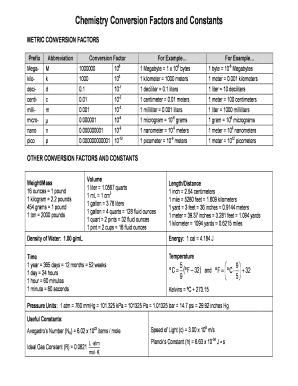Loading

Get Conversion Factors In Chemistry 2020-2025
How it works
-
Open form follow the instructions
-
Easily sign the form with your finger
-
Send filled & signed form or save
How to fill out the Conversion Factors In Chemistry online
Filling out the Conversion Factors In Chemistry form can help users understand various units of measurement used in scientific calculations. This guide will provide clear instructions to ensure that users can accurately complete the form online.
Follow the steps to accurately fill out the form.
- Click ‘Get Form’ button to access the form and open it in your preferred editing tool.
- Review the section on metric conversion factors, which lists prefixes, abbreviations, and their corresponding conversion factors. Ensure that you understand each prefix (e.g., mega, kilo, centi) and its numerical value.
- Move to the examples provided in the form, which illustrate how to apply conversion factors for various units, such as meters, liters, and grams. Familiarize yourself with how to convert between different units.
- Continue to the section on other conversion factors and constants, which cover weight, volume, length, density, energy, time, temperature, pressure units, and useful constants like Avogadro’s number.
- Carefully complete each relevant field in the form based on the information available in the sections listed above.
- Once all necessary fields are completed, review your entries for accuracy and completeness.
- Finally, save your changes, download the completed form, print it, or share it as needed.
Start filling out the Conversion Factors In Chemistry form online today to enhance your understanding of measurement conversions.
The meaning of conversion in chemistry pertains to the transformation of units or quantities during calculations. This process ensures that you represent measurements correctly and accurately in your experiments. To navigate these conversions smoothly, embracing conversion factors in chemistry is vital, as they serve as the bridge between different units.
Industry-leading security and compliance
US Legal Forms protects your data by complying with industry-specific security standards.
-
In businnes since 199725+ years providing professional legal documents.
-
Accredited businessGuarantees that a business meets BBB accreditation standards in the US and Canada.
-
Secured by BraintreeValidated Level 1 PCI DSS compliant payment gateway that accepts most major credit and debit card brands from across the globe.


